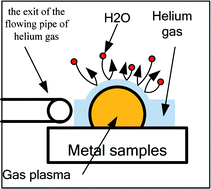The most difficult issue as regards hydrogen (H) analysis using the laser-induced plasma technique is the disturbance of H emission by H2O molecules. This problem is essentially solved in this paper by employing a novel technique that makes use of the specific characteristics of a TEA CO2 laser. Thus, a small helium gas plasma was produced by focusing a TEA CO2 laser onto a zircaloy surface containing H atoms. High-purity helium (He) gas was passed over the focusing point during the experiment so that the plasma was totally covered by the He gas and the H2O molecules remaining in the surrounding gas could not attack the plasma region. This technique ensures that only hydrogen atoms come out from the melted region of the sample surface, and are excited via metastable He atoms. This method has allowed us to confirm that H alpha (Hα), H beta (Hβ), H gamma (Hγ), and H delta (Hδ) emission can clearly be detected from a hydrogen-containing zircaloy sample with no interference from host emission lines or the H emission arising from H2O. The intensity ratio of Hα, Hβ, and Hγ was compared with that obtained for a low pressure hydrogen discharge lamp.

You have access to this article
 Please wait while we load your content...
Something went wrong. Try again?
Please wait while we load your content...
Something went wrong. Try again?


 Please wait while we load your content...
Please wait while we load your content...